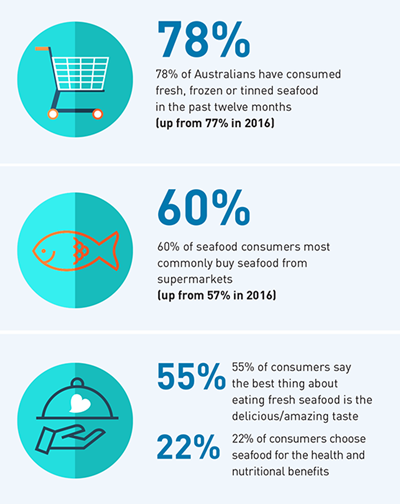
NEW data from the FRDC’s 2019 Unpacking the Consumer Seafood Experience survey, has revealed information on Australian seafood consumer attitudes.
The survey asked where consumers get their information from and broadened the demographic data compared to previous surveys.
Key findings:
Almost 80 per cent of those surveyed reported that they had consumed seafood in the past 12 months:
- 12 per cent rarely consumed seafood
- seven per cent never consumed it
- one per cent were unsure.
This does not reflect frequency or volume of consumption, but provides an overall incidence of consumption.
Of those who eat seafood, almost all indicated they eat fresh seafood (92 per cent), frozen (87 per cent) and tinned (86 per cent).
However, the survey found that consumers fall into one of three consumption segments in relation to the frequency with which they consume seafood, namely:
- frequent eaters (once a week or more) represent 33 per cent of consumers, but a whopping 77 per cent of all consumption;
- regular eaters (once a fortnight to once a month) represent 32 per cent of consumers and about 20 per cent of seafood consumed; while
- infrequent eaters (no more than once every two months) represent another 26 per cent of consumers and consume only three per cent of seafood purchased in Australia.

The survey indicated that supermarkets remain the major outlet for the purchase of seafood.
FRDC’s Peter Horvat says understanding that frequent eaters account for such a large proportion of consumption can direct producers to where they can get the biggest bang for their buck.
“If you try and convert infrequent eaters to double their seafood consumption, you will only make a small gain overall,” Horvat said.
“But if you target your messaging and marketing to increase the intake by those already eating seafood once a week or more, a small increase in consumption by that group is likely to have a far greater impact.” He said.
Despite seafood being purchased by most consumers, their confidence in buying and preparing remains moderately weak, scoring 6.4 out of 10 for preparing and cooking seafood and 7.1 out of 10 for confidence in buying seafood. However, the survey also highlights the desire for consumers to consume seafood.
“To overcome this, education and information on the different species, what they taste like and how to cook them could be vital, regardless of whether the seafood is fresh or frozen,” Horvat said.
For fishers who catch and supply the most well-recognised and commonly consumed species, the research indicates that the focus should be on packaging, presentation, improving ease of use (meal solutions) and preparation tutorials.
For fishers who catch and supply lesser-known species, investing in consumer education, information and tastings might be better options.
For seafood processers, the results show that consumers are open to new products, but they will need to be educated about what the product is and how to use it. Further findings are to be presented at the Seafood Directions conference in Melbourne in October.
Drivers of seafood consumption:
Freshness
How long has the seafood been in store? (74%)
Safety
How safe is it to eat? (74%)
Price
How does the price compare to other meats? (71%)
Quality
Is it fresh or has it been frozen?(66%)
Presentation
How long will it last at home? (63%)
For more information: www.frdc.com.au
















